By Philip Cauchi
The practices that form this session target to develop the communication levels between the defenders and to recognise when to remain compact and delay play and when to be more aggressive in order to win the ball. To keep things simpler and highlight the details that both the players and the coach should focus on we will use only eight players. To increase the challenge of the players we play without goalkeepers. This forces the defenders to play collectively and time their movements in a rhythm to block the direct route to the goal while limiting the attacking players’ space to finish on goal.
Session title: Develop compactness and cohesion during the defensive phase of play.
Total duration: Approximately 90 minutes.
Moment of play: Opponents in possession.
Team task: Deny scoring.
Players involved: The central defenders and the central midfielders.
Theme: Defending in central areas in the defending third.
Aim: Prevent the opponents from scoring, win the ball and initiate the counter attack.
Principles of play: Compactness and defensive depth.
Sub-principles of play: Zonal marking, angles and distances between the players and shifting according to the movement of the ball as a unit.
Sub-sub-principles of play: Who, when and how to apply pressure on the ball, cover the defender applying pressure on the ball, give balance to the defense unit, marking stance, and distance and angle of marking.
Methodology: The players are immersed into situations which requires them to work together to deny the opponents scoring opportunities. Therefore we use different scenarios where the same principles, sub-principles and sub-sub-principles are continuously reinforced through repetition. We call this ‘repetition without repetition’, which means that the same principles are applied repeatedly to solve similar problems (in our case when the opponents have the ball close to our goal). This method requires the players to continuously search for the better solution while the situation (environment) is continuously changing. It means that at one point the defenders have to deal with the ball in the middle of the pitch, then on the right side, the left side, an open ball, a closed ball, etc. This method involves the coach guiding the players towards finding the right solutions as a sector without giving the answers.
Warm-up – technical-tactical activation
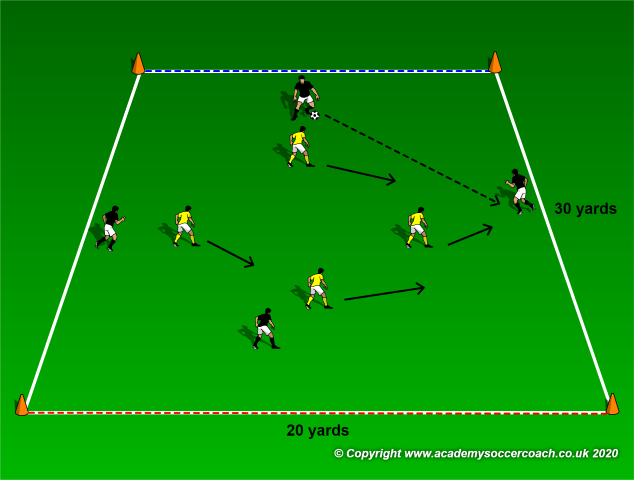
N.B. Prior to this activity carry out a 10 minute movement preparation session.
Duration: 10 minutes.
Aim: To prepare the players to work on the team shape during the phase of non-possession.
Set-up: Area measures 30 yards by 20 yards. Players are divided into two teams of four players each.
Description of exercise: One team aims to guide the ball over the red dotted line and the other over the blue dotted line. Focus is on the team’s defensive structure, not to allow the opponents to play forward and intercept the ball. Players are not allowed to tackle but are allowed to intercept passes. The players of the team in possession play with a two touch maximum.
Progression: Dribbling is allowed. However, the players of the defending team are allowed to position themselves accordingly in order to deny the advancement of the dribbler.
Game: Line soccer
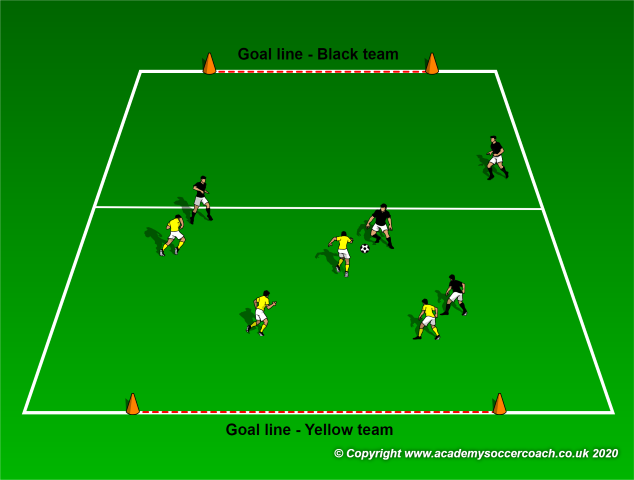
Duration: 16 minutes (3 series x 4 minutes with 2 minutes recovery between series).
Aim: To apply the principle of compactness, applying pressure, cover and balance in defence.
Set-up: Area measuring 30 yards by 20 yards. The area is divided into two equal horizontal zones.
Description of exercise: Both teams score by dribbling through the opponents’ goal line. No corner kicks take place.
Variation: To increase the intensity and make the defenders work more aggressive to win the ball, the attackers score a point if they make five consecutive passes inside the defending team’s half.
Functional practice 1: 3v2 with scoring zones and no goalkeepers
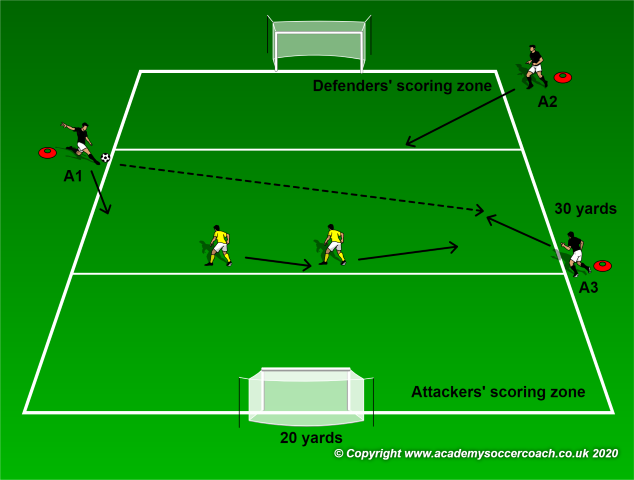
Duration: 15 minutes.
Aim: To work on the distances, angles and shifting as a unit.
Set-up: Area measures 30 yards by 20 yards. The area is further divided into three equal horizontal zones with the outer zones being the scoring zones as seen in the diagram. Two players are defenders and three are attackers. If we have more than three attackers, they take turns.
Description of exercise: Attacker A1 starts with the ball. He can either dribble the ball or pass to any other teammate to start the attack. The defenders aim not to let the attackers score from inside the attacker’s scoring zone. If the defenders win the ball they counter on the opposite goal and must score from inside their assigned scoring zone.
Variation: Play two attackers against two defenders and a neutral player. The neutral player plays with the team in possession. Thus when the defenders win the ball, they have a numerical superiority of 3v2 to counter.
Functional practice 2: 4v3 (recovering defender) with scoring zones and no goalkeepers.
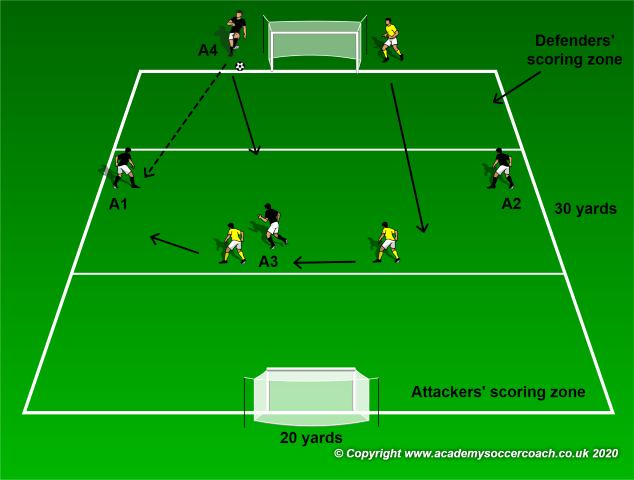
Duration: 20 minutes.
Aim: To work on delaying play until the right moment to attack the ball is on.
Set-up: Area measures 30 yards by 20 yards. The area is further divided into three equal horizontal zones with the outer zones being the scoring zones as seen in the diagram. In this practice we have four attackers and three defenders.
Description of exercise: The attack starts in the situation depicted in the above diagram. Attacker A4 plays the ball to any of the three attackers. At that same moment the ball is played, another defender recovers back to form a compact unit of three. Attacker A4 joins the attack after passing the ball. The attackers score from inside their marked scoring zone while the defenders aim to prevent the attackers from scoring, win the ball and counter to score from inside their scoring zone.
Variation: Play three attackers v three defenders and two neutral players.
Variation: 4+target player v 3
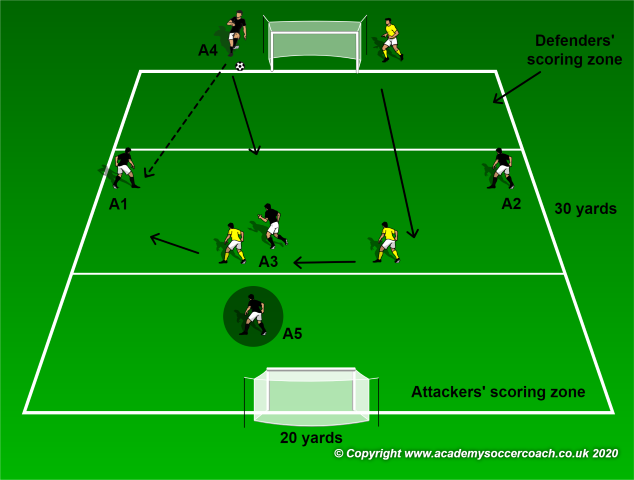
The attacking team scores two points after combining with the target player A5 to finish on goal (shown below) and one point if scored by any other means.
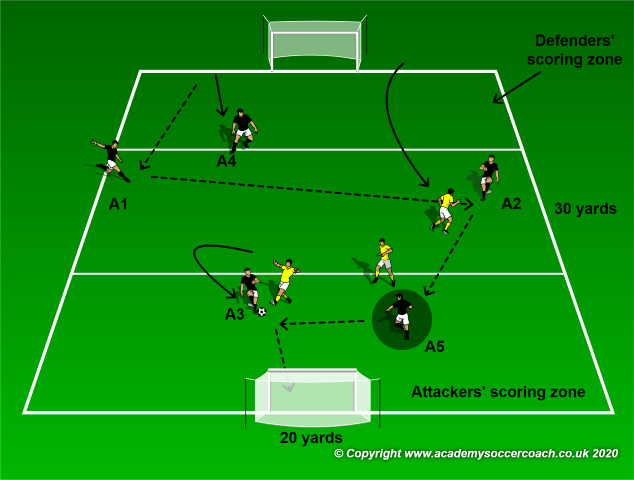
Game: Scoring from inside the opponents’ half.
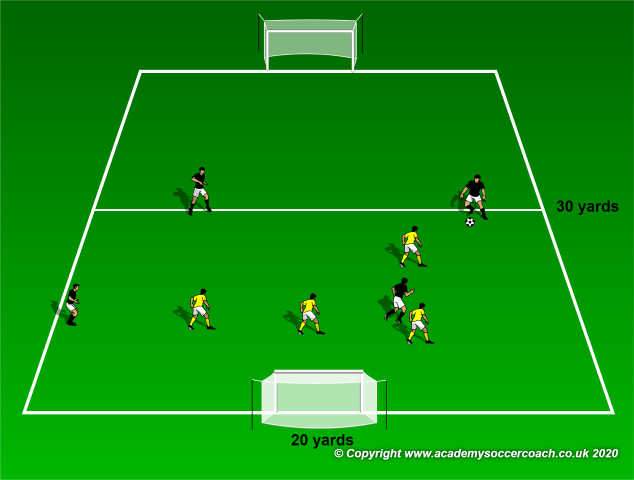
Duration: 22 minutes (4 series x 4 minutes with 2 minutes recovery between series).
Aim: To apply the principle of compactness, applying pressure, cover and balance in defence.
Set-up: Area measuring 30 yards by 20 yards. The area is divided into two equal horizontal zones.
Description of exercise: Normal game except goals may only be score from the opponents’ defensive half of the pitch. Normal restarts take place if the ball gets out of the playing area.
Variation: To increase the intensity and make the defenders work more aggressive to win the ball, the attackers score a point if they make five consecutive passes inside the defending team’s half.
Cool down: Light passing between two players followed by static stretching exercises. This should not take longer than 10 minutes in total.
An evaluation session with the players takes place at the end of practice.
Q1: What was the aim of the team that didn’t have the ball?
A1: To prevent conceding a goal, win the ball and counter.
Q2: How could the team achieve its aim?
A2: By reducing the space and time the opponents had to take a shot on goal.
Q3: Who should apply pressure on the ball?
A3: The first (closest) defender.
Q4: Where should the first defender force the attacker on the ball?
A4: Towards the outside.
Q5: Why should the first defender force the attacker on the ball towards the outside?
A5: To close down the shooting angle and reduce the attacker’s space and playing options.
Q6: When should the first defender attempts to tackle to win the ball?
A6: When the attacker on the ball has a bad touch, or a pass is played short, or when the attacker drops his head.
Q7: What if the first defender gets beaten with a pass or a dribble?
A7: The covering defender should apply pressure to attack the ball or delay while the closest defender to him provides cover.
By Philip Cauchi


